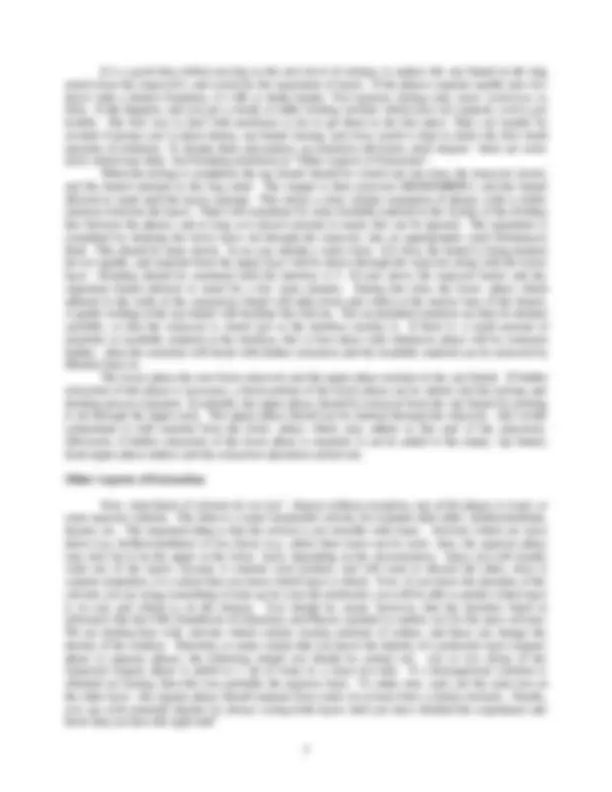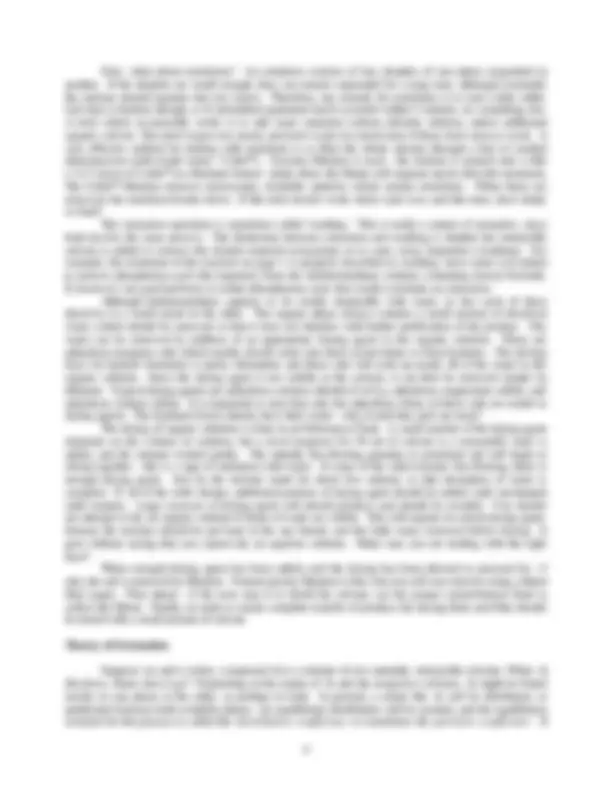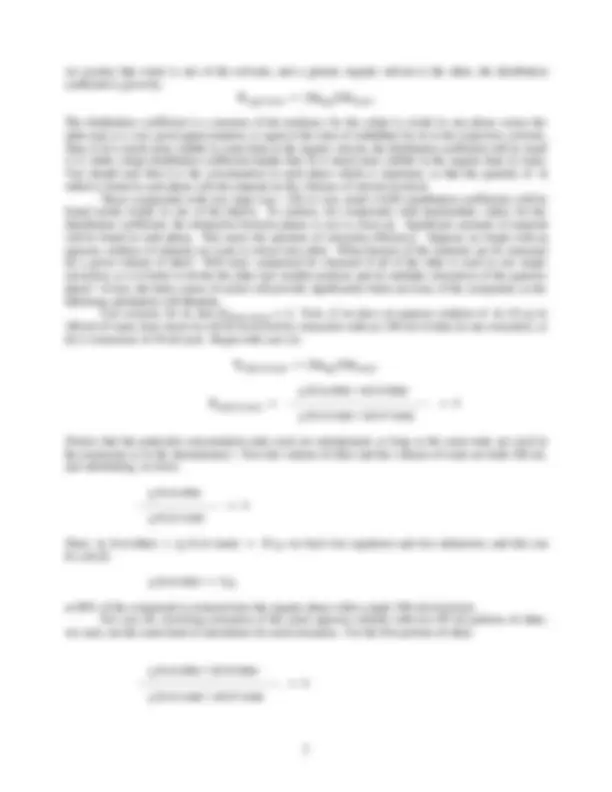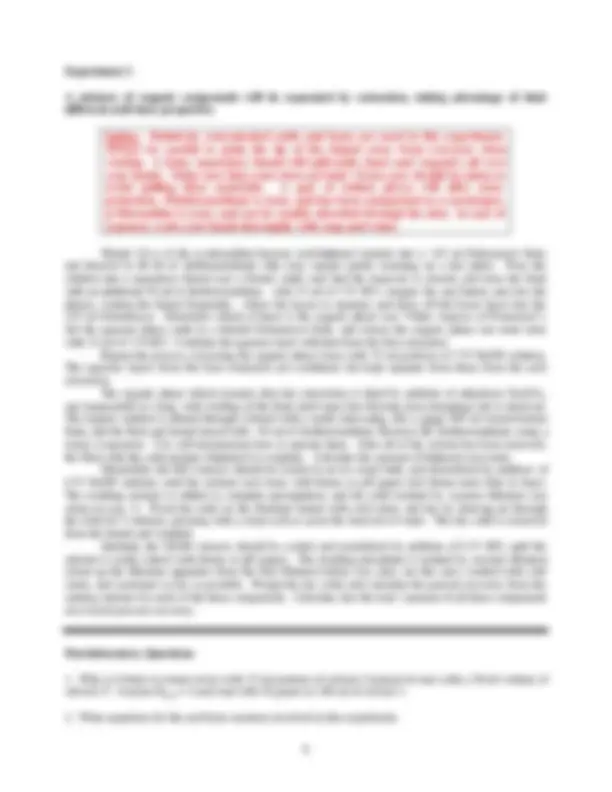






Study with the several resources on Docsity

Earn points by helping other students or get them with a premium plan


Prepare for your exams
Study with the several resources on Docsity

Earn points to download
Earn points by helping other students or get them with a premium plan
Community
Ask the community for help and clear up your study doubts
Discover the best universities in your country according to Docsity users
Free resources
Download our free guides on studying techniques, anxiety management strategies, and thesis advice from Docsity tutors
Material Type: Lab; Class: Organic Laboratory I; Subject: Chemistry; University: University of Missouri - Columbia; Term: Unknown 1989;
Typology: Lab Reports
1 / 8

This page cannot be seen from the preview
Don't miss anything!





W. H. Bunnelle, L. A. Meyer, R. E. Glaser (Version 4)
Introduction
Chances are, everyone in this class has done an extraction, probably several of them. Ever make a cup of tea or a pot of coffee? Anything but instant, and you've done extraction. Simply put, extraction involves mixing of mutually insoluble materials, where a component of one of the phases moves into the other. To make a cup of tea, hot water is mixed with dried tea leaves. The leaves are not soluble in the water, so there are two immiscible phases, the solid and the water. However, the water dissolves some of the compounds originally present in the tea leaves - these materials are extracted into the water. On the other hand, the preparation of a cup of instant coffee is not an extraction at all. Instant coffee powder is completely soluble in the water, and so there is no second phase. This is simply a process of solution. Extractions are often classified according to the nature of the phases involved. The water-tea leaves system is an example of liquid-solid extraction, and one can think of many such examples where components migrate from a solid phase to a liquid phase and vice versa. In this experiment, we will be concerned with liquid-liquid extraction, a very common laboratory operation which can be used as a separation or purification technique. Consider the following reaction:
This is a fairly standard organic reaction, involving the conversion of an alcohol to an alkyl halide. For now, imagine that we have the crude reaction mixture, which contains the organic product benzyl bromide (1), and phosphorous acid in dichloromethane solvent. How do we separate these to get the pure product? It turns out that a very simple way to separate the phosphorous acid from the organic material is to add water. The dichloromethane solvent is immiscible with water, and separates as a second layer, the organic phase. Now the molecules of benzyl bromide can stay in the organic phase, or migrate to the water layer, the aqueous phase. What property will determine where these molecules go? The tendency for a compound to reside in a solution is, of course, measured by its solubility. Benzyl bromide has a very much greater solubility in dichloromethane than in water, and so essentially all of this compound remains in the organic layer. For the phosphorous acid, on the other hand, the situation is just the opposite. As a very polar, ionized material, H 3 PO 4 , is much more soluble in water than in dichloromethane. Consequently, the phosphorous acid molecules will migrate out of the dichloromethane phase into the aqueous layer, much like those water-soluble constituents of tea leaves. Quite obviously, extraction will only work for separation of materials which have very different solubilities. It is a technique used most often for rudimentary purification, or what we call work-u p, of crude reaction mixtures. Now, if the dichloromethane layer can be removed and the aqueous layer left behind, we will achieve, in a very simple way, a separation of the products of the reaction. The device used to carry out this separation is called a separatory funnel (see Figure 1). It does resemble a funnel, if you use your imagination a bit. The glass body has a conical shape like a funnel, but this one closes at the top to a ground-glass joint, which can be shut with a stopper. The stem of the separatory funnel incorporates a stopcock, so that flow out of the bottom of the funnel can be interrupted. A separatory funnel is well-designed for its function. The larger volume at the top of the funnel is helpful for mixing the phases when the funnel is inverted, and the tapering lower portion of the funnel permits clean separation of the phases.
CH 2 OH
CH 2 Br
CH 2 Cl 2
Figure 1. The separatory funnel in the ring stand (left), and venting the funnel (right).
How to Use a Separatory Funnel
Operation of a separatory funnel is not difficult, but there are several potential pitfalls which must be avoided. The first order of business is to get the two liquid phases in the funnel. Make sure the stopcock is closed! This may be obvious, but every year, without fail, some students forget or don't pay attention, and wind up with a mess on the benchtop, and precious little product. Just in case, double check. The funnel is suspended in an iron ring -- choose one that allows free passage of the stopcock, and catches the separatory funnel about 1/2 - 1 inch below its widest part. The ring should be clamped high enough on a ring stand so that a collection vessel (usually an Erlenmeyer flask) will fit beneath the lower tip of the funnel when it is in place in the ring. Use a funnel to fill the sep funnel. It is important not to contaminate the ground joint at the top. If you get some grit or insoluble material on the joint, it will not seal tightly when you stopper it, and will leak all over your hands when you invert the funnel for mixing. By the way, you should make sure that your stopper and stopcock don't leak anyway. Before you try a 'real' extraction, take some water into the sep funnel, shake it around, and look carefully for leaks. If it does, check with your TA for help - you may have a misfit stopper or stopcock. Now, with both phases together, stopper the funnel and remove from the iron ring. With one hand cupped over the stopper end of the funnel (and holding the stopper in place between the fingers), and the other hand cradling the stopcock, gently invert the separatory funnel so that the contents run back to the fat end of the funnel, leaving the stopcock end empty. Now, with the sep funnel held at about a 45° incline, and with the stopcock end facing away from you and away from your lab neighbors, open the stopcock. You will hear a pfffft, as excess pressure vents from the sep funnel. Where does this pressure come from? There are many possibilities, depending on the extraction. In some cases, a gas (CO 2 ) is evolved, in others the warmth of your hands is enough to vaporize some volatile solvent, causing a pressure increase. Often there is a small heat of mixing which causes the same thing. This can go both ways, in fact, sometimes a vacuum is created. Regardless, it is very important to vent the separatory funnel repeatedly during use. Since the pressure increase can be substantial, especially when CO 2 is generated in the mixing, you should always begin cautiously - one gentle inversion of the sep funnel and vent. Next, close the stopcock, and gently rock the funnel back and forth one or two times. Vent again. Continue this process for several cycles, until you are sure that the phases have mixed thoroughly. The mixing may gradually become more vigorous, from rocking to sloshing to shaking, but never for more than a few seconds at a time, and always with frequent and repeated venting. Of course, you must make certain that the narrow neck of the funnel is completely drained before opening the stopcock, the pressure will squirt any remaining liquid out through the stopcock.
Now, what about emulsions? An emulsion consists of tiny droplets of one phase suspended in another. If the droplets are small enough, they can remain suspended for a long time, although eventually the mixture should separate into two layers. Therefore, one remedy for emulsions is to wait a little while. Lab time is limited, though, so if substantial separation hasn't occurred within 5 minutes, try something else. A trick which occasionally works is to add some saturated sodium chloride solution, and/or additional organic solvent. But don't expect too much, and don't waste too much time if these don't seem to work. A very effective method for dealing with emulsions is to filter the whole mixture through a bed of crushed diatomaceous earth (trade name: Celite®). Vacuum filtration is used - the mixture is poured onto a thin (~1/2") layer of Celite®^ in a Buchner funnel. Quite often, the filtrate will separate nicely after this treatment. The Celite®^ filtration removes microscopic, insoluble particles which sustain emulsions. When these are removed, the emulsion breaks down. If this trick doesn't work, better start over, and this time, don't shake so hard! The extraction operation is sometimes called 'washing.' This is really a matter of semantics, since both involve the same process. The distinction between extraction and washing is whether the immiscible solvent is added to remove the desired material (extraction) or to carry away impurities (washing). For example, the treatment of the reaction on page 1 is properly described as washing, since water was added to remove phosphorous acid (the impurity) from the dichloromethane solution containing benzyl bromide. If, however, our goal had been to isolate phosphorous acid, that would constitute an extraction. Although dichloromethane appears to be totally immiscible with water, in fact each of these dissolves to a small extent in the other. The organic phase always contains a small amount of dissolved water, which should be removed so that it does not interfere with further purification of the product. The water can be removed by addition of an appropriate 'drying agent' to the organic solution. These are anhydrous inorganic salts which readily absorb water into their crystal lattice to form hydrates. The driving force for hydrate formation is pretty substantial, and these salts will soak up nearly all of the water in the organic solution. Since the drying agent is not soluble in the solvent, it can then be removed simply by filtration. Typical drying agents are anhydrous calcium chloride (CaCl 2 ), anhydrous magnesium sulfate, and anhydrous sodium sulfate. It is important to note that only the anhydrous forms of these salts are useful as drying agents. The hydrated forms already have their water - why would they pick up more? The drying of organic solutions is done in an Erlenmeyer flask. A small amount of the drying agent (depends on the volume of solution, but a level teaspoon for 50 ml of solvent is a reasonable start) is added, and the mixture swirled gently. The initially free-flowing granular or powdered salt will begin to clump together - this is a sign of saturation with water. If some of the solid remains free-flowing, there is enough drying agent. Just let the mixture stand for about five minutes so that absorption of water is complete. If all of the solid clumps, additional portions of drying agent should be added, until unclumped solid remains. Large excesses of drying agent will absorb product, and should be avoided. You should not attempt to dry an organic solution if drops of water are visible. This will require too much drying agent. Instead, the mixture should be put back in the sep funnel, and the bulk water removed before drying. It goes without saying that you cannot dry an aqueous solution. Make sure you are dealing with the right layer! When enough drying agent has been added, and the drying has been allowed to proceed for ~ min, the salt is removed by filtration. Normal gravity filtration is fine, but you will save time by using a fluted filter paper. Plan ahead - if the next step is to distill the solvent, use the proper round-bottom flask to collect the filtrate. Finally, in order to ensure complete transfer of product, the drying flask and filter should be rinsed with a small amount of solvent.
Theory of Extraction
Suppose we add a solute, compound A to a mixture of two mutually immiscible solvents. When A dissolves, where does it go? Depending on the nature of A and the respective solvents, A might be found mostly in one phase or the other, or perhaps in both. In general, a solute like A will be distributed, or partitioned between both available phases. An equilibrium distribution will be reached, and the equilibrium constant for this process is called the distribution coefficient , or sometimes the partition coefficient. If
we assume that water is one of the solvents, and a generic organic solvent is the other, the distribution coefficient is given by: Korg/water = [ A ]org/[ A ]water
The distribution coefficient is a measure of the tendency for the solute to reside in one phase versus the other and, to a very good approximation, is equal to the ratio of solubilities for A in the respective solvents. Thus, if A is much more soluble in water than in the organic solvent, the distribution coefficient will be small (<1), while a large distribution coefficient implies that A is much more soluble in the organic than in water. You should note that it is the concentration in each phase which is important, so that the quantity of A which is found in each phase will also depend on the volumes of solvent involved. Those compounds with very large (say, >20) or very small (<0.05) distribution coefficients will be found nearly totally in one of the phases. In contrast, for compounds with intermediate values for the distribution coefficient, the distinction between phases is not so clear-cut. Significant amounts of material will be found in each phase. This raises the question of extraction efficiency. Suppose we begin with an aqueous solution of material we want to extract into ether. What fraction of the material can be extracted for a given volume of ether? Will more compound be extracted if all of the ether is used in one single extraction, or is it better to divide the ether into smaller portions and do multiple extractions of the aqueous phase? In fact, the latter course of action will provide significantly better recovery of the compound, as the following calculations will illustrate. Let's assume, for A , that Kether/water = 4. Now, if we have an aqueous solution of A (10 g) in 100 ml of water, how much A will be recovered by extraction with (a) 100 ml of ether in one extraction, or (b) 2 extractions of 50 ml each. Begin with case (a):
Kether/water = [ A ]org/[ A ]water
g A in ether / ml of ether Kether/water = = 4 g A in water / ml of water
(Notice that the particular concentration units used are unimportant, as long as the same units are used in the numerator as in the denominator.) Now the volume of ether and the volume of water are both 100 ml, and substituting, we have:
g A in ether = 4 g A in water
Since: (g A in ether) + (g A in water) = 10 g, we have two equations and two unknowns, and this can be solved:
g A in ether = 8 g,
or 80% of the compound is extracted into the organic phase with a single 100 ml extraction. For case (b), involving extraction of the same aqueous solution with two-50 ml portions of ether, we carry out the same kind of calculation for each extraction. For the first portion of ether:
g A in ether / ml of ether = 4 g A in water / ml of water
remove acidic materials, but particular care must be taken to vent the separatory funnel early and often during the extraction. The reaction of acid with these bases generates CO 2 gas, and the pressure buildup in a closed separatory funnel can be dangerous.
H-A + NaHCO 3 → Na+^ A-^ + H 2 O + CO 2 (g) (acid)
These points will be illustrated in the laboratory by the use of extraction to separate a mixture of three compounds. The solid mixture consists of varying amounts of p-nitroaniline, biphenyl, and benzoic acid.
O 2 N NH 2 CO 2 H
p-nitroaniline (^) biphenyl benzoic acid
The first of these is an amine derivative, and therefore basic. Biphenyl is a typical organic hydrocarbon, and is neither acidic or basic, while benzoic acid, as already discussed, is an acid. The mixture will be separated according to the scheme outlined below:
O 2 N NH 3 +Cl- O 2 N NH 2
CO 2 -^ Na+^ CO 2 H
p-nitroaniline
benzoic acid
biphenyl
in CH 2 Cl 2 extract with3N HCl
benzoic acid
biphenyl
neutrilize with NaOH
aqueous
aqueous
organic
organic
extract with 3N NaOH
neutrilize with HCl
dry, r emove solvent by distillation
The mixture is dissolved in an organic solvent, and extracted first with aqueous HCl. The HCl combines with p-nitroaniline to form the amine hydrochloride salt, which moves to the aqueous phase. Separation of the layers provides an aqueous solution of the amine salt, and an organic solution of benzoic acid and biphenyl. The p-nitroaniline can be recovered from the aqueous solution by neutralizing the acid. This converts the amine salt back to the amine, which is not water-soluble, and precipitates. The amine is then collected by vacuum filtration (see Expt. 1). Meanwhile, the next step of the separation is to extract the organic phase with aqueous NaOH. The benzoic acid is converted to its sodium salt, and moves to the aqueous layer. On separation of the phases, one obtains an aqueous solution of the sodium benzoate, and the organic solution still containing biphenyl. The benzoic acid is recovered by acidifying the aqueous solution, which causes the benzoic acid to precipitate, whereupon it is isolated by filtration. The biphenyl is isolated by drying the aqueous solution to remove dissolved water, and finally distillation of the solvent - the biphenyl will remain as a non-volatile residue. The whole operation is accomplished simply in a short period of time using these principles of extraction. The three components are isolated in nearly pure form; minor contaminants could be removed, if desired, by recrystallization.
Experiment 2
A mixture of organic compounds will be separated by extraction, taking advantage of their different acid-base properties.
Safety: Relatively concentrated acids and bases are used in this experiment. Always be careful to point the tip of the funnel away from everyone when venting. A leaky separatory funnel will spill acids, bases and organics all over your hands. Make sure that yours does not leak! Extra care should be taken to avoid spilling these materials. A pair of rubber gloves will offer some protection. Dichloromethane is toxic, and has been categorized as a carcinogen. p-Nitroaniline is toxic, and can be readily absorbed through the skin. In case of exposure, wash your hands thoroughly with soap and water.
Weigh 3.0 g of the p-nitroaniline-benzoic acid-biphenyl mixture into a 125 ml Erlenmeyer flask, and dissolve in 40 ml of dichloromethane (this may require gentle warming on a hot plate). Pour the solution into a separatory funnel (use a funnel, make sure that the stopcock is closed), and rinse the flask with an additional 10 ml of dichloromethane. Add 15 ml of 3 N HCl, stopper the sep funnel, and mix the phases, venting the funnel frequently. Allow the layers to separate, and draw off the lower layer into the 125 ml Erlenmeyer. Determine which of these is the organic phase (see “Other Aspects of Extraction”). Set the aqueous phase aside in a labeled Erlenmeyer flask, and extract the organic phase one more time with 15 ml of 3 N HCl. Combine the aqueous layer with that from the first extraction. Repeat the process, extracting the organic phase twice with 15 ml portions of 3 N NaOH solution. The aqueous layers from the base extraction are combined, but kept separate from those from the acid extraction. The organic phase which remains after the extractions is dried by addition of anhydrous Na 2 SO 4 , one teaspoonful at a time, with swirling of the flask until some free-flowing (non-clumping) salt is observed. The organic solution is filtered through a funnel with a small cotton plug, into a tared 100 ml round-bottom flask, and the flask and funnel rinsed with ~10 ml of dichloromethane. Remove the dichloromethane using a rotary evaporator. TAs will demonstrate how to operate them. After all of the solvent has been removed, the flask with the solid product (biphenyl) is weighed. Calculate the amount of biphenyl recovered. Meanwhile, the HCl extracts should be cooled in an ice-water bath, and neutralized by addition of 6 N NaOH solution, until the mixture tests basic with litmus or pH paper (red litmus turns blue in base). The resulting mixture is chilled to complete precipitation, and the solid isolated by vacuum filtration (see setup on exp. 1). Wash the solid on the Buchner funnel with cold water, and dry by drawing air through the solid for 5 minutes, pressing with a clean cork to assist the removal of water. The dry solid is removed from the funnel and weighed. Similarly, the NaOH extracts should be cooled and neutralized by addition of 6 N HCl, until the mixture is acidic (check with litmus or pH paper). The resulting precipitate is isolated by vacuum filtration (clean up the filtration apparatus from the first filtration before you carry out this one), washed with cold water, and suctioned as dry as possible. Weigh the dry solid, and calculate the percent recovery from the starting mixture for each of the three compounds. Calculate also the total (amount of all three compounds recovered) percent recovery.
Post-laboratory Questions